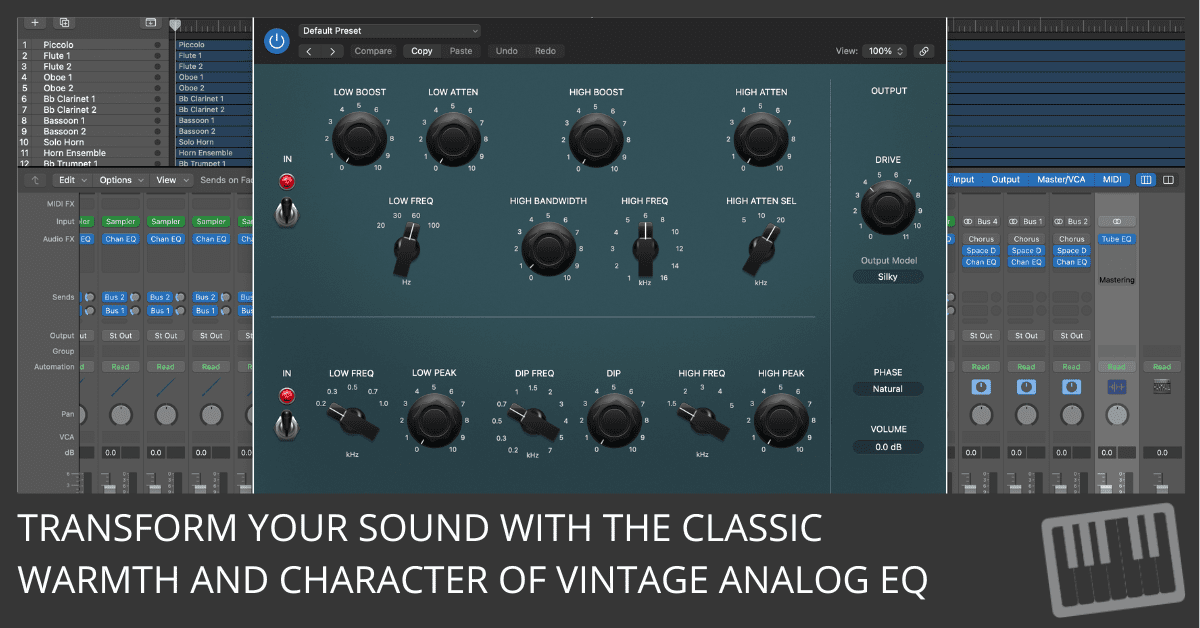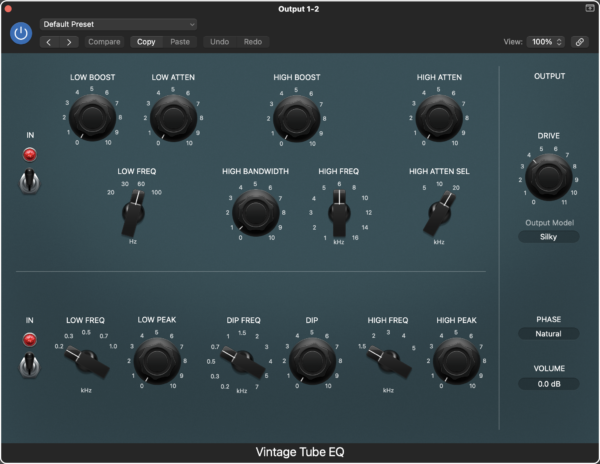
If you’re after that rich, analog sound but don’t have vintage equipment lying around, the Logic Pro Vintage Tube EQ is your new best friend.
Modeled after classic 1950s gear, this EQ brings analog warmth to the digital world, offering powerful boosts, smooth cuts, and harmonic color that adds life to any track. But to get that classic “Pultec” magic from it, you’ll need to know a few tricks.
Let’s master the Logic Pro Vintage Tube EQ and make it work wonders in your mixes.
Understanding the Vintage Tube EQ Layout
Logic’s Vintage Tube EQ draws inspiration from legendary analog units that helped shape the sound of recording for decades. This EQ is organized into three main sections:
- Low-Frequency Control: This section allows you to boost or cut frequencies from 20 Hz to 100 Hz, ideal for creating rich, thick, low-end.
- High-Frequency Boost: This control offers adjustable boosts between 3 and 16 kHz, perfect for adding brightness and clarity to vocals or guitars.
- High-Frequency Attenuation: This section lets you roll off highs at 5, 10, or 20 kHz to smooth out sharpness, which is especially useful for taming harshness in cymbals, strings, or sibilant vocals.
Additionally, a Bandwidth Control allows you to adjust the width of the high-frequency boost, giving you precision over how broad or narrow the effect is. Once you get familiar with this layout, the Vintage Tube EQ becomes more than just a plugin—a powerful tonal sculpting tool.

Making the Boost and Attenuate Technique Work for You
One of the biggest secrets of vintage EQs is the art of boosting and cutting the same frequency simultaneously. Known as the “Pultec trick,” this technique is simple to execute with the Vintage Tube EQ and adds depth without overpowering the mix. Here’s how to do it:
- Set the Low Frequency: Choose a low frequency, such as 60 Hz, if you’re working with a kick drum or bass.
- Apply a Boost: Start with a strong boost—around halfway to 13 dB—to achieve a full, powerful low end.
- Add a Low-Frequency Cut: Immediately after boosting, dial in a cut at the same frequency range. This creates a unique “dip” in the low-mid frequencies, balancing fullness with control.
This trick produces a thick, punchy low end that stays tight and clear, ideal for kick drums, bass, and even deep male vocals.
Getting Authentic Analog Warmth with the Drive Knob
If you’re after that elusive analog warmth, the Vintage Tube EQ’s Drive knob is your go-to. It adds subtle harmonic distortion, infusing tracks with character and fullness. Here’s how to use it:
- Set EQ Bands to Neutral: Start by setting all EQ bands with no boost or cut, allowing the Drive effect to act independently of other EQ changes.
- Increase the Drive Knob Gradually: Begin with a low setting, around 2-3, and slowly raise it. This lets you control the amount of saturation added.
- Apply to Key Tracks or Master Bus: Use Drive on individual tracks like vocals or guitars for warmth, or apply it to the entire mix on the master bus for a cohesive, analog-inspired touch.
This gentle saturation adds an organic quality that’s subtle but impactful. It brings effortless warmth to your tracks or overall mix.
Bringing Out Presence on Guitars (Without Harshness)
Sometimes, guitars need to cut through the mix without sounding harsh. Here’s how to use the Vintage Tube EQ to achieve this balance:
- Set a High-Frequency Boost: Start by choosing a high-frequency boost around 4 kHz. This range adds presence and clarity without brittleness.
- Adjust the Bandwidth: Use the Bandwidth knob to shape the boost. A wider setting creates a smoother presence, while a narrower one adds more focused clarity.
- Tame Harshness with High Attenuation: If the guitar starts to sound too sharp, set the High Atten Sel knob to 10 kHz and reduce highs slightly using the High Atten knob. This smooths out any harshness, preserving punch without the “ice pick” effect.
This approach gives your guitar clarity and presence in the mix while keeping it smooth and balanced.
Enhancing Vocals with the Andrew Scheps Trick
Parallel compression can keep vocals clear and steady, even in busy mixes. Here’s how to use the Vintage Tube EQ for a strong vocal presence:
- Create a Parallel Track: Set up a second track specifically for parallel compression.
- Add the First Vintage Tube EQ: On this track, use the Vintage Tube EQ to roll off lows around 100 Hz to cut out rumble. Then, boost at 8 kHz to enhance vocal clarity and brightness.
- Apply a Compressor: Follow with an LA2A-style compressor, applying heavy compression to add focus and consistency.
- Add a Second Vintage Tube EQ: Use another instance of the EQ to bring back some low-end warmth and soften any excessive highs.
- Blend with the Main Vocal Track: Mix this parallel track back in with the main vocal for a sound that’s both clear and steady.
This setup ensures that your vocals remain present and well-defined, regardless of what happens in the rest of the mix.
Giving the Master Bus a Polished, Harmonic Finish
If you want to add warmth to your entire mix, try using the Vintage Tube EQ on the master bus. Here’s a simple setup:
- Insert the Vintage Tube EQ: Place the EQ on your master bus for a final polish on the overall mix.
- Set Bands to Neutral: Keep all EQ bands at zero without any boosts or cuts. This allows the EQ’s natural harmonic color to subtly enhance your mix.
- Raise the Drive Knob Slightly: Increase the Drive knob just a bit to introduce gentle saturation, adding a touch of analog warmth.
- Add Optional Boosts for Extra Magic: For a bit more presence, try a small boost at 8 kHz for airy highs or a bump at 60 Hz for added low-end weight.
This setup brings a subtle but rich enhancement to the mix, making it feel cohesive and polished.
The Guitar Trick for Added Clarity
For clear, balanced guitar tones that don’t overpower the mix, try this approach with the Vintage Tube EQ:
- Set a Subtle High-Frequency Boost: Adjust the High Freq knob to around 4 kHz, boosting gently by 4-6 dB to add presence without harshness.
- Fine-tune with Bandwidth: Use the Bandwidth control to shape the boost, aiming for a curve that makes the guitar stand out without becoming piercing.
- Tame Excessive Highs: If the guitar sounds too sharp, set the High Atten Sel to 10 kHz and add a touch of High Atten. This smooths out the top end, keeping the guitar audible but never overbearing.
This technique brings clarity to guitars, helping them pop in the mix without clashing with other elements.
Using the Vintage Tube EQ with Bass Instruments
To achieve depth in bass without muddiness, the Vintage Tube EQ is an excellent choice. Here’s a quick setup:
- Set Low Frequency for Depth: Start by setting the Low Freq knob around 30 Hz and apply a boost of 5-8 dB. This creates a deep, warm foundation.
- Use Low Atten to Shape Low Mids: Dial in a slight Low Atten to cut the low mids, removing any muddiness and keeping the bass clean and defined.
This technique adds body without making the bass overwhelming—ideal for styles like rock, hip-hop, or jazz, where a thick yet clear bassline is essential.
Fine-Tuning the EQ for Realistic Sound
For overall tone, think of the Vintage Tube EQ as a broad-stroke paintbrush rather than a precision tool. This EQ shines in its musicality, adding warmth and character to your mix:
- Adjust High Bandwidth for Sound Shaping: Use a wider bandwidth for smooth, polished tones or a narrower boost to highlight specific details without harshness.
These settings enhance the mix’s professional feel, providing warmth and dimension without sacrificing that classic analog vibe.
Blending for Subtle Saturation and Final Touches
As a final touch, consider subtle saturation across all elements in a track or mix. The Drive knob on the Vintage Tube EQ is perfect here—set it around 2-3 to start, then adjust to taste. This subtle drive is almost unnoticeable alone but adds cohesion when applied across several tracks. It’s like glue for your mix, unifying everything with an analog touch that keeps things natural and warm.
Wrapping Up
The Logic Pro Vintage Tube EQ is a powerhouse for any producer aiming to bring warmth, color, and character to their mixes. With these techniques, you’re set to harness its full potential—whether it’s the Pultec trick for tight low-end, the Drive knob for subtle saturation, or adding presence to guitars and vocals. So add the Vintage Tube EQ, try these techniques, and watch your mixes transform with depth and vibrance.
Enter your first name and email address and click the "Get Access Now!" button to get your free mixing guide.
Your Information is 100% Secure And Will Never Be Shared With Anyone!

Great tutorial thanks so much.
You’re welcome! Glad you liked it.